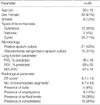1. Barker AF. Bronchiectasis. N Engl J Med. 2002. 346:1383–1393.

2. Naidich DP, McCauley DI, Khouri NF, Stitik FP, Siegelman SS. Computed tomography of bronchiectasis. J Comput Assist Tomogr. 1982. 6:437–444.

3. Muller NL, Bergin CJ, Ostrow DN, Nichols DM. Role of computed tomography in the recognition of bronchiectasis. Am J Roentgenol. 1984. 143:971–976.

4. Wong-You-Cheong JJ, Leahy BC, Taylor PM, Church SE. Airways obstruction and bronchiectasis: correlation with duration of symptoms and extent of bronchiectasis on computed tomography. Clin Radiol. 1992. 45:256–259.

5. Hansell DM, Wells AU, Rubens MB, Cole PJ. Bronchiectasis: funtional significance of areas of decreased attenuation at expiratory CT. Radiology. 1994. 193:369–374.
6. Smith IE, Jurriaans E, Diederich S, Ali N, Shneerson JM, Flower CD. Chronic sputum production: correlations between clinical features and findings on high resolution computed tomographic scanning of the chest. Thorax. 1996. 51:914–918.

7. Swartz MN. Fishman AP, Elias JA, Grippi MA, Kaiser LR, Senior RM, editors. Bronchiectasis. Fishman's pulmonary diseases and disorders. 1998. 3rd ed. New York: McGraw Hill;2045–2070.
8. Cochrane GM, Webber BA, Clarke SW. Effects of sputum on pulmonary function. Br Med J. 1977. 2:1181–1183.

9. Perry KMA, King DS. Bronchiectasis: a study of prognosis based on a follow-up of 400 patients. Am Rev Tuberc. 1940. 41:531–548.
10. Cherniack NS, Carton RW. Factors associated with respiratory insufficiency in bronchiectasis. Am J Med. 1966. 41:562–571.

11. Bhalla M, Turcios N, Aponte V, Jenkins M, Leitman BS, McCauley DI, Naidich DP. Cystic fibrosis: scoring system with thin-section CT. Radiology. 1991. 179:783–788.

12. Ip M, Lauder IJ, Wong WY, Lam WK, So SY. Multivariate analysis of factors affecting pulmonary function in bronchiectasis. Respiration. 1993. 60:45–50.

13. Ooi GC, Khong PL, Chan-Yeung M, Ho JCM, Chan PKS, Lee JCK, Lam WK, Tsang KWT. High-resolution CT quantification of bronchiectasis: clinical and functional correlation. Radiology. 2002. 225:663–672.

14. Roberts HR, Wells AU, Milne DG, Rubens MB, Kolbe J, Cole PJ, Hansell DM. Airflow obstruction in bronchiectasis: correlation between computed tomography features and pulmonary function tests. Thorax. 2000. 55:198–204.

15. Miszkiel KA, Wells AU, Rubens MB, Cole PJ, Hansell DM. Effects of airway infection by Pseudomonas aeruginosa: a computed tomographic study. Thorax. 1997. 52:260–264.

16. Webb WR, Muller NL, Naidich DP. Webb WR, Muller NL, Naidich DP, editors. Diseases characterized primarily by decreased lung opacity, including cystic abnormalities, emphysema, and bronchiectasis. High-resolution CT of the lung. 1996. 2nd ed. Philadelphia: Lippincott-Raven Publishers;234–241.
17. American Thoracic Society. Standardization of spirometry, 1994 update. Am J Respir Crit Care Med. 1995. 152:1107–1136.
18. Quanjer PH, Tammeling GJ, Cotes JE, Pedersen OF, Peslin R, Yernault JC. Lung volumes and forced ventilatory flows. Official statement of the European Respiratory Society. Eur Respir J Suppl. 1993. 16:5–40.
19. Morris JF. Spirometry in the evaluation of pulmonary function. West J Med. 1976. 125:110–118.
20. Reid LM. Reduction in bronchial subdivision in bronchiectasis. Thorax. 1950. 5:233–247.

21. Ellis DA, Thornley PE, Wightman AJ, Walker M, Chalmers J, Crofton JW. Present outlook in bronchiectasis: clinical and social study and review of factors influencing prognosis. Thorax. 1981. 36:659–664.

22. Osborne D, Vock P, Godwin JD, Silverman PM. CT identification of bronchopulmonary segments: 50 normal subjects. Am J Roentgenol. 1984. 142:47–52.

23. O'Riordan T, Wanner A. Baum GL, editor. Bronchiectasis. Textbook of pulmonary diseases. 1998. 6th ed. Philadelphia: Lippincott-Rave;816–817.
24. Loubeyre P, Paret M, Revel D, Wiesendanger T, Brune J. Thin-section CT detection of emphysema associated with bronchiectasis and correlation with pulmonary function tests. Chest. 1996. 109:360–365.

25. Bahous J, Cartier A, Pineau L, Bernard C, Ghezzo H, Martin RR, Malo JL. Pulmonary function tests and airway responsiveness to methacholine in chronic bronchiectasis of the adult. Bull Eur Physiopathol Respir. 1984. 20:375–380.
26. Dail DH. Dail DH, Hammar SP, editors. Bronchial and transbronchial diseases. Pulmonary pathology. 1994. 2nd ed. New York: Springer-Verlag;95–99.

27. Comroe JH Jr, Nadel JA. Screening tests of pulmonary function. N Engl J Med. 1970. 282:1249–1253.

28. American Thoracic Society. Lung function test: selection of reference values and interpretative strategies. Am Rev Respir Dis. 1991. 144:1202–1218.
29. Lynch DA, Newell J, Hale V, Dyer D, Corkery K, Fox NL, Gerend P, Fick R. Correlation of CT findings with clinical evaluations in 261 patients with symptomatic bronchiectasis. Am J Roentgenol. 1999. 173:53–58.

30. Nicotra MB, Rivera M, Dale AM, Shepherd R, Carter R. Clinical, pathophysiologic, and microbiologic characterization of bronchiectasis in an aging cohort. Chest. 1995. 108:955–961.

31. Angrill J, Agusti C, de Celis R, Filella X, Rano A, Elena M, De La Bellacasa JP, Xaubet A, Torres A. Bronchial inflammation and colonization in patients with clinically stable bronchiectasis. Am J Respir Crit Care Med. 2001. 164:1628–1632.

32. Angrill J, Agusti C, de Celis R, Rano A, Gonzalez J, Sole T, Xaubet A, Rodriguez-Roisin R, Torres A. Bacterial colonization in patients with bronchiectasis: microbiological pattern and risk factors. Thorax. 2002. 57:15–19.
33. Evans SA, Turner SM, Bosch BJ, Hardy CC, Woodhead MA. Lung function in bronchiectasis: the influence of Pseudomonas aeruginosa. Eur Respir J. 1996. 9:1601–1604.
34. Ho PL, Chan KN, Ip MSM, Lam WK, Ho CS, Yuen KY, Tsang KWT. The effect of Pseudomonas aeruginosa infection on clinical parameters in steady-state bronchiectasis. Chest. 1998. 114:1594–1598.

35. Rivera M, Nicotra MB. Pseudomonas aeruginosa mucoid strain. Its significance in adult chest diseases. Am Rev Respir Dis. 1982. 126:833–836.
36. Woods DE, Straus DC, Johanson WG Jr, Berry VK, Bass JA. Role of pili in adherence of Pseudomonas aeruginosa to mammalian buccal epithelial cells. Infect Immun. 1980. 29:1146–1151.
37. Barghouthi S, Guerdoud LM, Speert DP. Inhibition by dextran of Pseudomonas aeruginosa adherence to epithelial cells. Am J Respir Crit Care Med. 1996. 154:1788–1793.












 PDF
PDF ePub
ePub Citation
Citation Print
Print




 XML Download
XML Download